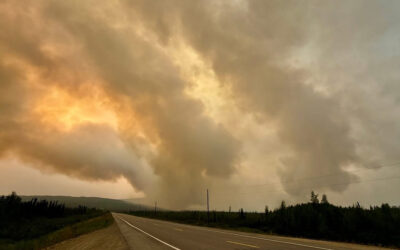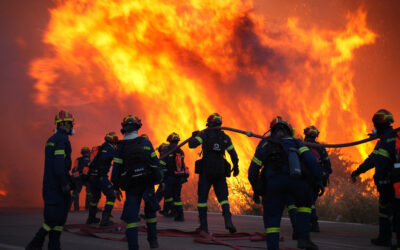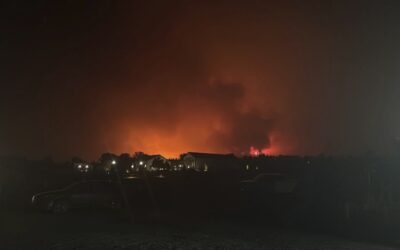The right things are the projects that probably have not been addressed because of the amount of work that goes along with them
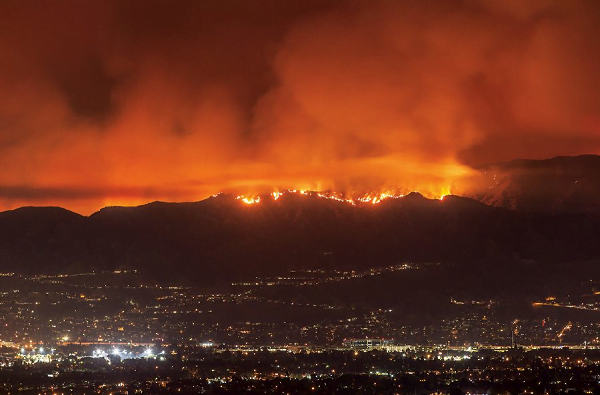
When there is smoke in the air and wildfires on the news, this is when everyone seems to pay attention to the possible threat looming in their towns. To preplan is to have some foresight on what’s about to happen. (Photo by Scott L./Flickr.)
Recently, I was fortunate enough to attend the inaugural Firefighter Health and Safety Cancer Symposium in Phoenix, Arizona. The conference focus was on educating our brothers and sisters on reducing cancer in the fire service. I saw many lectures from outstanding people who showed courage, passion, and dedication to our craft. I learned about the pathophysiology of the dreaded “C” word to try and better understand an enemy on the fireground that has been lurking for quite some time. There were many presentations on how to prevent exposure to troops so we can make sure that everyone can enjoy their retirement. It was an amazing experience, and I honestly believe that it was one of the best conferences I have ever been to. I think this was because of the overwhelming feeling of everyone in attendance to want and do the right thing.
What’s the right thing? In what context do we deliver it? How do we measure it? I know that I have tried to navigate my career by always thinking about the larger picture and making sure that all my actions are with the best interest of the department and our customers in mind—anything less is unacceptable. We can use this methodology to analyze our current needs as a department and identify any gaps. This can be overwhelming to say the least. Every chief has a long laundry list of ideas and projects that he feels need to be done. What do we choose first? How do we accomplish it? How do we know what is a priority? It is usually the task that is the most important at the time, but I will argue that is not necessarily the right thing. The right thing is the one that poses the biggest threat to our customer. This could be a staffing issue, a target hazard that has yet to be strategized, or even a risk to the community that seems too large to tackle. The easy projects are the ones that take very little research to accomplish. They may seem satisfying at first but, in the end, can be delegated with very little oversight. The right ones are the projects that probably have not been addressed because of the amount of work that goes along with them.
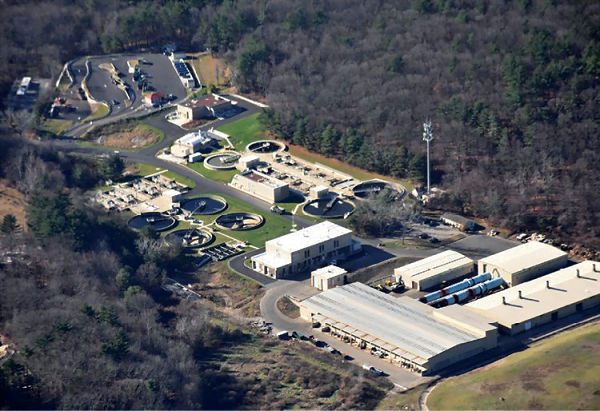
We can identify a sewage treatment plant in our community—what hazards exist. Now, let’s throw in a significant wildfire starting next to the treatment plant. What potential hazards exist, and do we change our overall strategy? (Photo by Nick Allen.)
As Easy as It Seems?
Let’s take a look at preplanning. Preplanning seems to most a very easy and simple task. Well, that’s because most of the work has been accomplished before you started as a brand-new firefighter and even knew what a preplan was. The brothers and sisters who put all the hard work into the project labored countless hours over the format, information, and layouts. To “update” or “revise” a preplan is somewhat easy and basic. The larger issue is looking at preplanning the entire community. We can identify a sewage treatment plant in our community—what hazards exist, what type of hazmat potential it has, what our incident action plan is if there is a catastrophic failure, and what type of exposure to our community it poses. This seems to be some more low hanging fruit when preplanning our district.
Now, let’s throw in a significant wildfire starting next to the treatment plant. What potential hazards exist, and do we change our overall strategy? Is there defensible space? Have we looked at this major hazard in our community with a wildland fuel mitigation plan? Have we coached the plant managers on how we successfully come up with some positive factors to improve our overall triage of the plant to ensure it is defendable?
When there is smoke in the air and wildfires on the news, this is when everyone seems to pay attention to the possible threat looming in their towns. To start thinking about a plan on how you’re going to deal with this threat during the “wildfire season” is poor planning. This is called reactionary management. To preplan is to have some foresight on what’s about to happen. It would take tremendous effort to pull off an incident action plan in the wildland urban interface (WUI) once a fire is taking a run at your town. This plan takes months if not years to formulate. We must institute confidence in our customers by thinking about the overall incident with a proper risk management strategy.
Community Connection
Let’s get back to the sewage plant. How can we incorporate defensible space, mitigation strategies, and triage factors that we educate the plant officials on into more of a community approach? We could hold yet another public meeting at our fire hall to educated our constituents. If this worked, all of us in the WUI would have the safest communities on the planet. The hard part is reaching everyone so we have community continuity.
How do we do this? What is the right thing to do? It’s quite simple. Get out there and train. Train on the streets, roads, and subdivisions where you are going to be doing the real work. Interact with the neighborhood. Show them you care. Pull hose around houses, size up structures, shuttle water, lay in progressive hoselay packs, triage structures, and most importantly train like you fight. Don’t talk about, do it. I guarantee that if you are drilling at a subdivision, the homeowners will become engaged. This opportunity will benefit you and your organization. You can educate them on how to make their homes safer for both them and the firefighters.
Community Preplanning
Everyone wants to interact with their local fire department. Make the opportunity for them. Customers who become engaged will, in turn, engage with others, and soon you are addressing entire subdivisions in your district. This is exactly where you start preplanning your community, addressing the overall needs of an area and not having tunnel vision on a specific group of homes. To take it further, we can identify how many engines we will need, what type of water resources there are, what type of fuel loads there are, where the safety zones are, where a good lookout position is, and what our second means of egress is, to name a few.
On a larger scale, we come up with positioning of support, logistics, and operations. We can make contact on the front end to the major players in our community to start and keep the conversation going. Let’s talk to the public works, Department of Transportation, city officials, law enforcement, Red Cross, and local EMS organizations. Let’s approach community volunteer organizations and share the notion of helping each other. Let’s have open and honest conversations with the leadership in our communities about our abilities and capabilities. Let’s preplan together. Let’s have everyone involved in the conversation.
Open Communication
When we navigate through our busy careers, we always have the best of intentions for our customers, community, and fire department in mind. If we can realize this in ourselves, we can look at our community with a whole different lens. Understanding that everyone has the best of intentions and it is our interpretation of others’ actions that are the variable is paramount.
Everyone wants a safer community. Everyone wants to feel protected. Everyone wants to be part of the discussion. Everyone wants to help have a safer place to raise their kids and grow as a community. The fire department needs to supply the platform for those voices to be heard. This will pay dividends in the long term. By showing support and respect, the fire department will benefit in time of need when the big show comes to town. Be that avenue for communication. Plan for the worst day imaginable. Preplan the whole town. Show you care. Do the right thing!
 Seth Barker is a captain and training officer for the Big Sky (MT) Fire Department. He is a state fire instructor for the Montana Fire Service Training School and a state lead EMS instructor. Barker holds a Blue Card Instructor certification, is an ISFSI instructor, and is a logistical coordinator for FirefighterCloseCalls.com. He is one of the scholarship recipients to the Tampa 2 Summit held by the National Fallen Firefighters Foundation. Barker is a contributing author for FireRescue and sits on multiple wildland-urban interface committees. He has taught for the Fire Department Instructors Conference International, delivering multiple topics on preparing communities in all-hazard disciplines. Barker is one of the Principal of Modern Fire Attack instructors and instructor trainers. He has the live fire instructor certification and the training officer credential through the International Society of Fire Service Instructors (ISFSI). Barker was elected director at large for the ISFSI. He has fire officer and chief training officer designations from the Center for Public Safety Excellence.
Seth Barker is a captain and training officer for the Big Sky (MT) Fire Department. He is a state fire instructor for the Montana Fire Service Training School and a state lead EMS instructor. Barker holds a Blue Card Instructor certification, is an ISFSI instructor, and is a logistical coordinator for FirefighterCloseCalls.com. He is one of the scholarship recipients to the Tampa 2 Summit held by the National Fallen Firefighters Foundation. Barker is a contributing author for FireRescue and sits on multiple wildland-urban interface committees. He has taught for the Fire Department Instructors Conference International, delivering multiple topics on preparing communities in all-hazard disciplines. Barker is one of the Principal of Modern Fire Attack instructors and instructor trainers. He has the live fire instructor certification and the training officer credential through the International Society of Fire Service Instructors (ISFSI). Barker was elected director at large for the ISFSI. He has fire officer and chief training officer designations from the Center for Public Safety Excellence.

